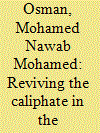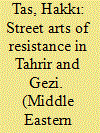| Srl | Item |
| 1 |
ID:
099660


|
|
|
|
|
| Publication |
2010.
|
| Summary/Abstract |
Hizbut Tahrir (HT) is a transnational Islamic movement operating in over forty-five countries. Literature on HT has focused mainly on its activities in Central Asia and Europe. As such, when the HT chapter in Indonesia organized the largest-ever political gathering staged by HT, many observers were caught by surprise. Yet despite the importance of Hizbut Tahrir Indonesia (HTI), little is known about the organization in the English-speaking world. This paper is an attempt to present empirical data on this group. The paper argues that HTI's usage of different mobilization strategies has resulted in its ability to effect policy changes in Indonesia.
|
|
|
|
|
|
|
|
|
|
|
|
|
|
|
|
| 2 |
ID:
153594


|
|
|
|
|
| Summary/Abstract |
With the tremendous visibility of popular mobilization in the last decade, scholars have increasingly directed their attention to the streets to examine the dynamics of power and resistance. Among emerging venues of politics, this study examines street art and graffiti as a performance of resistance in the 2011 Tahrir Revolution and 2013 Gezi Protests in Egypt and Turkey, respectively. As re-appropriation of the urban landscape and modes of self-expression, street art and graffiti lie at the intersection of politics, space, and identity. Inspired by James C. Scott's concept of ‘arts of resistance’, this study takes up these ‘street arts of resistance’ as revealing the hidden transcript, namely, the self-disclosure of subordinates under the politics of disguise. While unpacking that subversive power, this study rests on its claim that street art and graffiti not only seek to represent, but also to perform and interject. Thereafter, it examines how these modes of visual culture interrupt time, space, and the self, along with their respective effects.
|
|
|
|
|
|
|
|
|
|
|
|
|
|
|
|